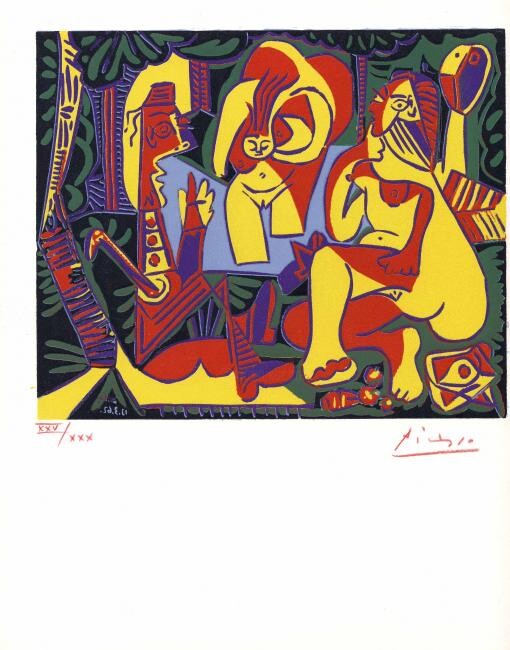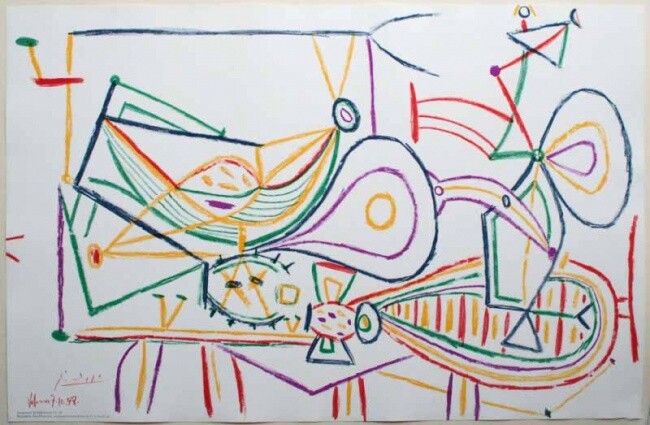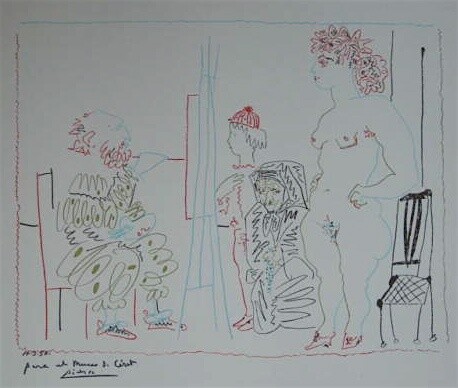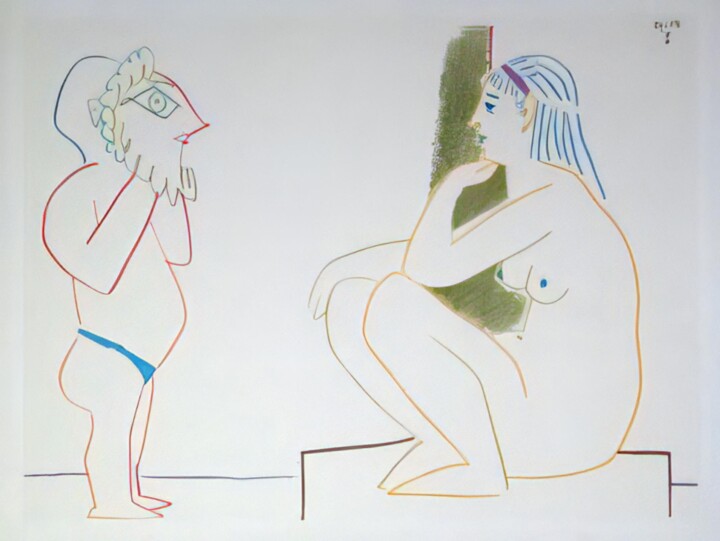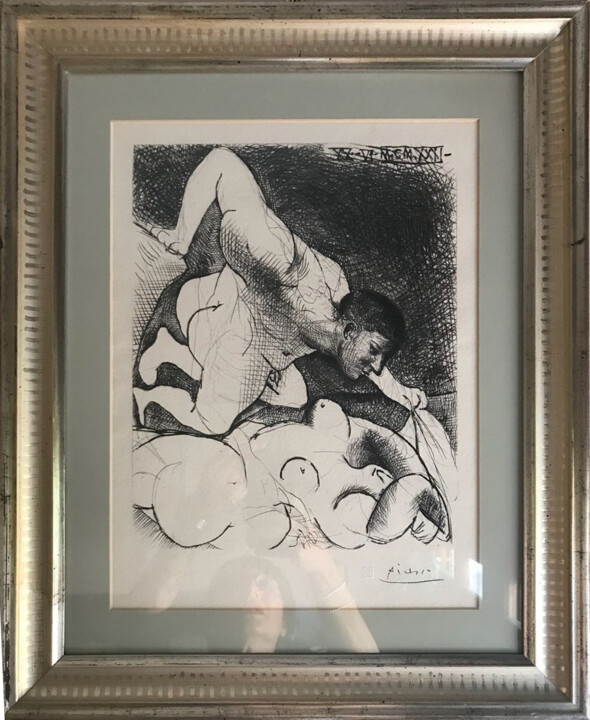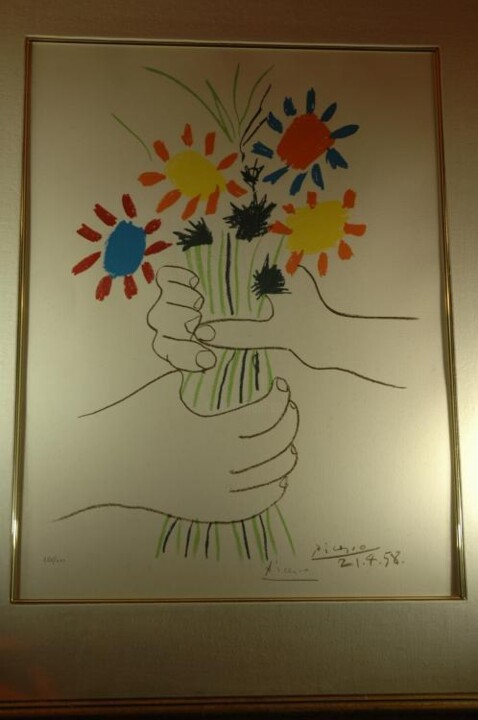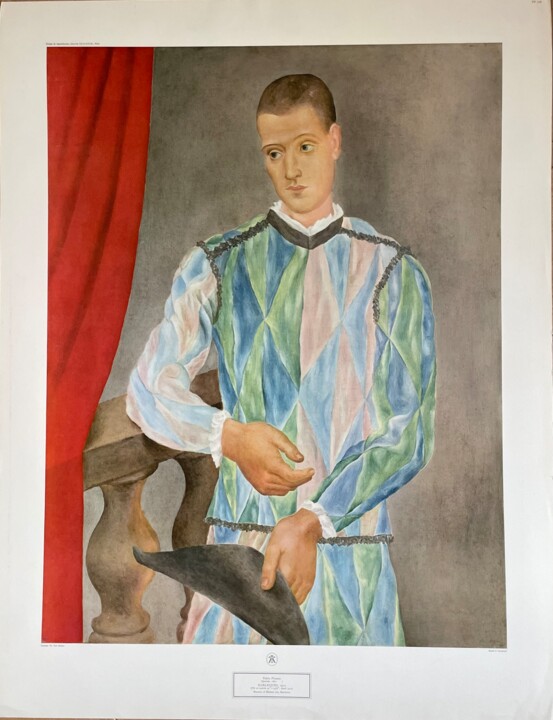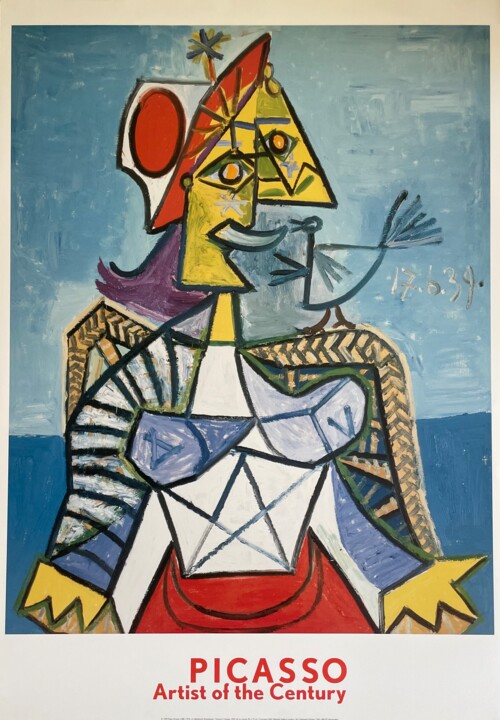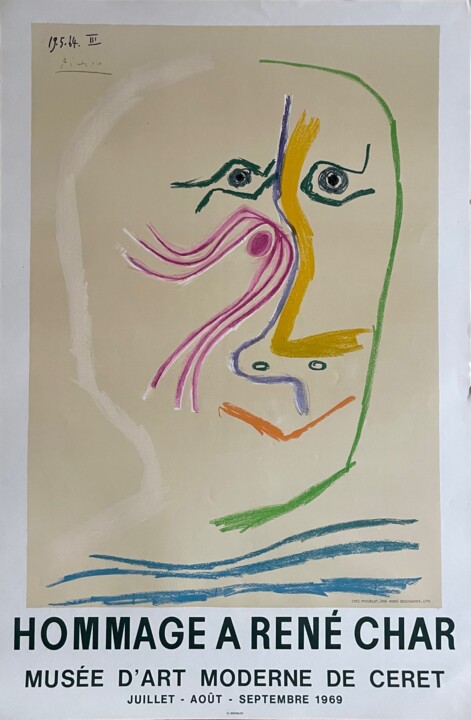Pablo Picasso, born in Málaga, Spain, on October 25, 1881, is celebrated as one of the most influential artists of the 20th century, having left an indelible mark on the art world through his groundbreaking contributions to movements such as Cubism and Surrealism. His innovative approach to art, which included the co-invention of collage and the creation of constructed sculpture, spanned a wide array of styles and periods, from the Blue and Rose Periods to his later works that often merged elements of his earlier experiments. Throughout his prolific career, Picasso's works, including masterpieces like Les Demoiselles d'Avignon and Guernica, reflected his evolving artistic vision and solidified his legacy as a revolutionary figure in modern art.
Artist Biography: Pablo Picasso
Pablo Ruiz Picasso was born on October 25, 1881, in Málaga, Andalusia, Spain, the first child of Don José Ruiz y Blasco and María Picasso y López. Growing up in a middle-class family, Picasso was immersed in art from an early age, guided by his father, a skilled painter and art professor. His innate talent for drawing was evident from childhood, with his first words reportedly being a playful abbreviation of the Spanish word for "pencil." From the age of seven, Picasso received formal training in figure drawing and oil painting, fostering a disciplined approach to art that contrasted with his later rebellious spirit. The family's move to A Coruña in 1891 allowed Picasso to further develop his skills, though his father's decision to abandon painting after recognizing his son's superior technique marked a pivotal moment in young Picasso's artistic journey.
Tragedy struck in 1895 when Picasso's seven-year-old sister, Conchita, died of diphtheria, prompting the family to relocate to Barcelona. There, Picasso thrived academically and artistically, gaining entry to the School of Fine Arts at just thirteen years old. Despite his lack of discipline in formal settings, his exceptional talent earned him recognition and admiration. At sixteen, Picasso moved to Madrid to attend the Real Academia de Bellas Artes de San Fernando, but his disdain for traditional instruction led him to abandon formal studies. Instead, he immersed himself in the rich artistic heritage of the Prado Museum, drawing inspiration from masters like El Greco, whose influence is evident in Picasso's later works. Picasso's personal life was as vibrant and tumultuous as his art. Throughout his life, he maintained numerous intense relationships, which deeply influenced his creative output. He married twice and had four children with three different women, each relationship leaving an indelible mark on his work. Picasso's muses, including Olga Khokhlova, Marie-Thérèse Walter, and Dora Maar, played significant roles in his artistic evolution, serving as subjects and inspirations for some of his most renowned pieces. However, his relationships were often marked by emotional turbulence and tragedy, with several of his partners and children suffering from mental health issues and untimely deaths.
Politically, Picasso remained largely detached from direct involvement in movements such as the Catalan independence struggle, although he expressed general support and maintained friendships with activists. During the Spanish Civil War, he took on the honorary role of "director of the Prado" in absentia, helping to safeguard the museum's collection. The horrors of the war profoundly impacted him, leading to the creation of his iconic anti-war painting, Guernica. In 1944, Picasso joined the French Communist Party, aligning himself with leftist ideologies and actively supporting peace movements. His political commitments were reflected in his art, most notably in works like Massacre in Korea and the universally recognized "Dove of Peace." Picasso's life came to an end on April 8, 1973, in Mougins, France, from pulmonary edema and a heart attack. He was interred at the Château of Vauvenargues, a property he had cherished since 1958. The aftermath of his death was marked by personal tragedy, as his wife Jacqueline Roque took her own life in 1986, devastated by Picasso's passing.
Style & Technique
Over his long career, he produced an astounding body of work that spanned multiple mediums, including painting, sculpture, ceramics, drawing, printmaking, and even textiles. The sheer volume of his creations, with more than 45,000 unsold works at the time of his death, is a testament to his relentless drive and versatility. In painting, he utilized color as an expressive element but leaned heavily on drawing to establish form and spatial relationships. His innovative approach sometimes included adding unconventional materials like sand to his paint, creating varied textures and enriching the tactile quality of his work. A scientific analysis of his painting The Red Armchair (1931) revealed that Picasso used common house paint in his artworks, confirming long-held suspicions and showcasing his willingness to break traditional boundaries. Picasso’s sculptural work also reflects his innovative spirit. Early in his career, he worked with traditional materials like wood, wax, and clay, but from 1909 to 1928, he shifted towards creating sculptural constructions from a wide array of materials. His Guitar (1912), made of sheet metal and wire, is a prime example of this approach, which has been described as a three-dimensional counterpart to his Cubist paintings—a radical departure from conventional sculpting techniques.
Whether it was the sombre tones of his Blue Period, the warmth of his Rose Period, or the fragmented forms of Cubism, Picasso’s style was fluid and ever-evolving. He often painted from imagination or memory, producing works that reflected his personal experiences and relationships, which has led many to view his oeuvre as a vast pictorial autobiography. This autobiographical aspect is reinforced by Picasso’s habit of meticulously dating his works, as he aimed to leave a complete documentation of his artistic journey. Picasso’s Cubist works, though bordering on abstraction, never entirely divorced themselves from the real world. His paintings often featured recognizable objects like guitars, violins, and bottles, even as they were broken down into geometric forms. While large narrative scenes were rare in his paintings, Guernica (1937) stands as a monumental exception, capturing the horror of war in a powerful, complex composition.
Brief History of Cubism
Cubism, a revolutionary early-20th-century art movement that emerged in Paris, profoundly transformed painting and the visual arts, with its influence extending into music, ballet, literature, and architecture. Pioneered by Pablo Picasso and Georges Braque, Cubism broke with traditional perspectives by analyzing subjects, breaking them down, and reassembling them in abstract forms that depicted multiple viewpoints simultaneously. This movement, which drew inspiration from the late works of Paul Cézanne, is often considered the most influential art movement of the 20th century. Initially developed in Paris's Montmartre and Montparnasse neighborhoods, and later in nearby Puteaux, Cubism was marked by its radical departure from the depiction of realistic space, leading to various offshoots such as Orphism, Purism, and abstract art. The movement introduced collage as a modern art form and influenced a host of other artistic movements including Futurism, Suprematism, Dada, and Constructivism. The history of Cubism is typically divided into phases, beginning with Analytic Cubism, which emerged between 1910 and 1912, characterized by a fragmented approach to form and space. This was followed by Synthetic Cubism, which remained vital until the rise of Surrealism around 1919. Another categorization includes "Early Cubism," "High Cubism," and "Late Cubism," with each phase representing different stages of development and experimentation within the movement. Despite its evolution and the emergence of various interpretations, Cubism's impact remained pervasive, influencing not only visual arts but also contributing to a broader ideological shift towards modernity and mechanization in the early 20th century.
Iconic Artworks
Among his most famous pieces is Guernica (1937), a monumental anti-war painting that powerfully conveys the horrors of the Spanish Civil War. Les Demoiselles d’Avignon (1907), a groundbreaking work, shattered traditional perspectives and paved the way for Cubism. The Old Guitarist (1904), from his Blue Period, captures the somber reality of human suffering, while Girl before a Mirror (1932) and Le Rêve (1932) are intimate portrayals of his muse Marie-Thérèse Walter, showcasing his fascination with psychological depth and surrealism. Picasso's early mastery is evident in works like First Communion (1896) and Science and Charity (1897), while his later creations such as Dove of Peace (1949) and Don Quixote (1955) highlight his enduring commitment to both simplicity and symbolism. The Three Dancers (1925) and Weeping Woman with Handkerchief (1937) reveal his exploration of emotional intensity, and Bull's Head (1942) exemplifies his ability to find art in the everyday. From the haunting melancholy of The Tragedy (1903) to the vibrant surrealism of The Kiss (1925), Picasso's oeuvre is a testament to his unceasing innovation and profound impact on 20th-century art.
Guernica (1937)
Pablo Picasso's Guernica (1937) stands as one of the most potent anti-war paintings in art history, encapsulating the inhumanity, brutality, and despair wrought by conflict through its stark imagery and intricate symbolism. Created in response to the April 26, 1937 bombing of the Basque town of Guernica during the Spanish Civil War, the painting transcends the specific atrocity to become a universal symbol of suffering caused by violence. The bombing, executed by Nazi Germany’s Condor Legion in support of Francisco Franco’s Nationalist forces, resulted in the deaths of hundreds of civilians, primarily women and children. Picasso, profoundly affected by these events, was commissioned to create Guernica for the Spanish Pavilion at the 1937 Paris International Exposition. The monumental canvas, measuring 3.5 meters by 7.8 meters, is rendered in a monochromatic palette of black, white, and gray, which intensifies its somber tone and emphasizes the gravity of its subject. The chaotic composition is filled with fragmented bodies, anguished expressions, and symbols of violence, with a bull standing impassively on the left and a horse, speared and screaming, dominating the center. Interpretations of the bull and horse vary, with some seeing the bull as a symbol of brutality and the horse as the suffering of the people, while others view these figures as more ambiguous. Picasso himself left the interpretation open, encouraging viewers to derive their own meanings. Guernica marked a significant shift in Picasso’s work towards political expression, influenced in part by his relationship with Dora Maar, a surrealist photographer and anti-fascist activist who documented the painting’s creation. The work gained political potency through international exhibitions, raising awareness and funds for Spanish refugees and becoming a symbol of resistance against fascism. After the war, Guernica was entrusted to the Museum of Modern Art (MoMA) in New York City, with Picasso stipulating that it should not return to Spain until democracy was restored. In 1981, six years after Franco’s death, the painting was finally transferred to Spain, where it now resides in the Museo Reina Sofía in Madrid. Guernica remains a timeless icon of not only the tragedy it depicts but also the broader human condition in the face of war and suffering, enduring as a stark reminder of the devastating impact of conflict and the power of art to bear witness to history.
Le Baiser (1932) by Pablo Picasso
Pablo Picasso, Le Baiser, 1932. Painting, Oil on Canvas, 37cm x 48cm.
Pablo Picasso's Le Baiser (1932) is a captivating example of his Cubist approach, immortalizing a tender moment through a masterful interplay of form and color. The painting, an oil on canvas, measures 48 cm by 37 cm and reveals Picasso’s unparalleled ability to dissect and reconstruct human emotion. At its heart, the work depicts a man and a woman engaged in a kiss, yet the moment is imbued with a profound sense of duality. The woman’s gaze is intimately directed towards her lover, while he, paradoxically, looks out towards the viewer, creating an intriguing disjunction between their shared experience and the observer's perspective. The canvas is predominantly rendered in a stark monochrome palette, but Picasso’s artistry transcends the simplicity of black and white through the subtle use of blue lines that form a dynamic backdrop, and a soft green shadow that gently accents the man’s figure. This understated splash of color breathes life into the composition, highlighting the emotional depth of the scene while maintaining a sophisticated balance. The painting's surface reveals its history, with a rich patina of time evident in the yellowed canvas and the delicate repair in the top right corner. An elegant frame, still in excellent condition, encloses the piece, which carries with it the charm of its 1932 Parisian origins. The verso of the work bears a gallery label from that era, connecting the painting to its storied past.
Then the Daughter of Pharaoh Opened the Basket and Saw That Within It Was a Child (2010) by Pablo Picasso
Pablo Picasso, Then the Daughter of Pharaoh Opened the Basket and Saw That Within It Was a Child, 2010. Printmaking, 50.5cm x 37cm.
This work, part of the Exodus Suite, reflects Picasso's engagement with the biblical narrative of Moses' discovery, a scene both revered and poignant. The print, an original lithograph on Velin Arches paper measuring 50.5 x 37 cm, emerges from a limited edition of 250 proofs. The composition is a vivid tableau where the act of unveiling becomes a profound encounter. The daughter of Pharaoh, poised in a moment of delicate anticipation, is depicted with an intensity that conveys both the gravity of her discovery and the grace of her gesture. The colors, a harmonious dance of bright hues and subtle shades, breathe life into the scene, juxtaposing the historical weight of the narrative with Picasso’s characteristic exuberance and modern sensibility. The lithograph, published by Leon Amiel in Paris and New York in 1966, stands as a testament to Picasso’s ability to infuse age-old stories with a fresh, dynamic perspective. Printed by the renowned Fernand Mourlot, this work is a luminous part of an ambitious project undertaken by Marc Chagall, who sought to illuminate the Exodus story through a suite of twenty-four lithographs. Picasso’s depiction, with its absence of margins, draws the viewer into an immersive experience, reflecting not just the moment of revelation but also the depth of human emotion and spiritual significance.
Auction History
Several of Pablo Picasso's paintings rank among the most expensive in the world, with numerous record-breaking sales at auction. Garçon à la pipe sold for $104 million at Sotheby's in 2004, followed by Dora Maar au Chat for $95.2 million in 2006. In 2010, Nude, Green Leaves and Bust, depicting Picasso's mistress Marie-Thérèse Walter, fetched $106.5 million at Christie's. His 1932 work, Women of Algiers, set a new record in 2015 when it sold for $179.3 million at Christie's in New York. Other notable sales include Femme Assise (1909), which sold for £43.2 million in 2016, setting a record for the highest price ever paid for a Cubist work, and Femme assise, robe bleu (1939), which was sold for $45 million in 2017 after being misappropriated during WWII. In 2018, Femme au Béret et à la Robe Quadrillée (1937), another portrait of Walter, sold for £49.8 million at Sotheby's in London.
Acknowledging his unparalleled impact, Picasso became the first artist honored with a special exhibition at the Louvre on his 90th birthday, and Robert Hughes noted that no artist, not even Michelangelo, had achieved such fame in their lifetime. Despite his fame, Picasso kept many of his works off the market, and upon his death, these, along with his collection of other artists' works, became the foundation for the Musée Picasso in Paris. Museums dedicated to Picasso, such as the Museu Picasso in Barcelona and Museo Picasso Málaga, house extensive collections of his early works and personal archives. Notably, Guernica was displayed at MoMA in New York before being returned to Spain, where it now resides at the Reina Sofía Museum. Picasso's legacy also extends to popular culture, being portrayed by actors such as Anthony Hopkins and Antonio Banderas, and his works continue to be highly valued, with Picasso remaining the top-ranked artist by auction sales as of 2015. His paintings have been the most frequently stolen, with over 1,000 listed as stolen by the Art Loss Register in 2012. In Basel, a 1968 referendum led to the successful public purchase of two of his paintings, after which Picasso donated additional works to the city, becoming an honorary citizen of Basel.




 Selena Mattei
Selena Mattei

